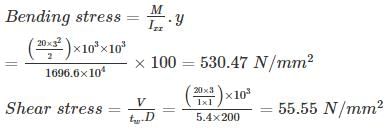Test: RCC Design- 2 - Civil Engineering (CE) MCQ
10 Questions MCQ Test - Test: RCC Design- 2
As per IS: 456 in a two – way slab, the width of the middle strip along each span should be:
The appropriate expression in assessing development length is:
| 1 Crore+ students have signed up on EduRev. Have you? Download the App |
For bars in tension, a standard hook has an anchorage value equivalent to a straight length of
A floor slab of thickness t is cast monolithically transverse to a rectangular continuous beam of span L and width B. If the distance between two consecutive points of contra flexure is, L0, the effective width of compression flange at continuous support is
Clear distance between lateral restrains for continuous reinforced concrete beam of size 250 × 500 mm (effective depth) according to IS 456:2000 shall be limited to:
It is proposed to reduce 20 mm diameter bar to 16 mm diameter in an axially loaded column. Grade of steel used is Fe500. Which one of the following lap length should be used if the design bond stress for M25 grade concrete is 1.4 MPa.
For a two way simply supported RC slab of size 3 m × 9 m effective span. The maximum spacing of distribution bars satisfying codal provisions as per IS 456 : 2000 is?
M-20 concrete and Fe-415 steel grade is used in the slab
A cantilever steel beam of 3 m span carries a uniformly distributed load of 20 kN/m inclusive of self-weight. The beam comprises ISLB200@198 N/m, flange 100 mm × 7.3 mm, web thickness 5.4 mm, Ixx = 1696.6 cm4, lyy = 115.4 cm4. Bending and shear stresses in the beam are respectively.
At limit state of collapse, an RC beam is subjected to flexural moment 200 kN.m, shear force 20 kN and torque 15 kN.m. The beam is 400 mm wide and 500 mm effective depth with 50 mm cover. The equivalent shear force and equivalent moment is :
A rectangular beam of 500mm × 800mm with an effective cover of 40 mm is subjected to a factored shear force 30 KN, a bending moment of 100 KN - m and a torsional moment of 15 KN - m. The design bending moment in KN - m for the beam will be ________
(Use shear resistance of the cross-section τc is 0.48 MPa)






 which ever is lesser
which ever is lesser = 31250 mm = 31.25m
= 31250 mm = 31.25m





















